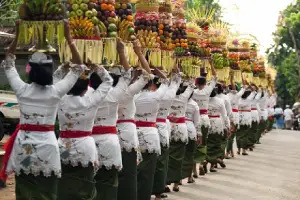Things to Do in Bali
Balinese Hinduism
Balinese Hindu faith is rooted on Vedic texts, ancient philosophies, and alternative lifestyles, all of which mutually support one another. To that end, Hinduism is not a dogmatic religion but rather the consequence of a spiritual way of life. Hinduism’s traditions, like the religion itself, evolve and change with time.
Hinduism was maintained as the primary faith of the Indonesian people via rituals, traditions, and the arts long before Islam was ever a presence in the country. It also introduced religious concepts, myths, and stories, as evident in the many celebrations honoring the dead and the gods of various cultures. Temples in Bali follow the same architectural principles as their Indian counterparts. The Balinese word for “temple” (Pura) refers to a sacred complex that is often encircled by walls. The island is home to over 20,000 temples, each of which is dedicated to a different virtue, region, or other category.
A genuine Balinese Hindu experience is a very personal and spiritual step on the path to self-discovery. The promise of “moksa,” or ultimate fulfillment, is central (becoming one with the universe). Balinese Hinduism has its origins in the unique spiritual traditions of the Nusantara (archipelago) and the enlightenments of saints who have lived on this land for thousands of years before the nation was ever founded.
Hinduism and Bali – Historical Background
The introduction of Hinduism to Bali was a gradual process influenced both by early Indian contact and, significantly, through the later influence of the Javanese Majapahit Empire.
1. Early Indian Influence (circa 1st – 7th centuries)
Trade and Early Contact
Indian traders arrived in the Indonesian archipelago, including Bali, as early as the 1st century. They established trading routes and cultural exchange points, particularly in Sumatra and Java. These traders brought with them elements of Hinduism and Buddhism, leading to the early adoption of Hindu and Buddhist iconography, social customs, and Sanskrit inscriptions. By the 7th century, these influences had extended to Bali, where Sanskrit inscriptions have been found, signifying the early spread of Hindu religious ideas and practices.
Balinese Adaptation of Hinduism
Early Hindu practices in Bali were adapted to local animistic and ancestor-worshipping beliefs, creating a unique blend of Hindu-Balinese spirituality that differed from Indian Hinduism. However, these early influences were relatively limited in scope and did not establish the full framework of Hindu culture in Bali.
2. The Role of the Majapahit Empire (14th – 16th centuries)
Majapahit Conquest (1343)
The Majapahit Empire in Java, particularly under the leadership of Gajah Mada, launched a series of conquests throughout the archipelago, including Bali. In 1343, the Majapahit forces formally conquered Bali, bringing with them a stronger and more structured form of Hinduism and Javanese culture. This conquest established Bali as a vassal state of the Majapahit Empire and led to increased immigration of Javanese Hindu nobles, priests, artists, and intellectuals to Bali.
Exodus of Hindu-Javanese Elites
As Islam spread in Java in the 16th century, particularly with the rise of the Demak Sultanate, a large-scale migration of Hindu-Javanese elites, including royal families, priests, artists, and scholars, occurred. These individuals sought refuge in Bali, bringing with them advanced practices of Hinduism and further influencing Balinese culture. The result was a deepening of Hindu rituals, social structures, and art forms, with Bali becoming a sanctuary for the preservation of Majapahit Hindu culture.
3. Lasting Cultural and Religious Impact
Formation of Balinese Hinduism
The integration of Indian-origin Hinduism and the structured practices of the Majapahit Hindu-Javanese form created the unique Agama Hindu Dharma practiced in Bali. This version of Hinduism adapted Indian deities, Javanese philosophical principles, and local Balinese animistic practices into a cohesive system.
While Indian traders introduced Hindu elements to Bali, the Majapahit Empire’s conquest and subsequent Hindu-Javanese migrations were crucial in establishing a more organized and culturally pervasive form of Hinduism. It was the Majapahit influence that solidified Hinduism in Bali’s social structure, religious practices, and arts, shaping it into the unique form seen today.
The Majahapit in Bali
In the 16th century, Bali became a refuge for Hindu-Javanese people as Islam rapidly spread through Java, culminating in significant changes to Balinese society, culture, religion, and governance. This influx of Hindu-Javanese people following the collapse of the Hindu Majapahit Empire in Java created an indelible influence on Bali. Here’s a breakdown of the migration’s significance:
Historical Context of Migration
Fall of Majapahit in Java
The Majapahit Empire, a dominant Hindu kingdom in East Java, began to decline in the early 16th century as Islam gained influence. By 1520, Islamic sultanates replaced Hindu dynasties across Java, pushing Hindu nobles, priests, artists, and warriors to Bali. Many sought to preserve their religious, artistic, and cultural practices, seeing Bali as a safe haven for their Hindu traditions.
Formation of Balinese Kingdoms
Bali’s existing kingdoms—such as those in Klungkung and Gianyar—were deeply influenced by the Majapahit culture, literature, governance systems, and religious practices. This migration fortified these kingdoms, eventually establishing a structured society where Bali served as a custodian of the Majapahit Hindu-Javanese legacy.
Majahapit Influence on Balinese Culture and Society
Hinduism and the Caste System
The Hindu-Javanese brought a refined caste system to Bali, categorizing society into distinct roles and responsibilities. This adaptation of Hinduism to local traditions led to the Balinese “Catur Varna” system, akin to the Hindu caste system but distinct in its integration with indigenous Balinese customs. The four major castes—Brahmana (priests), Ksatria (warriors), Wesia (merchants), and Sudra (farmers)—were adapted with flexibility in Bali but still held a significant social and spiritual role.
Bali Caste System
History of Hinduism as an official religion in Indonesia
Although Indonesia is a predominantly-Muslim nation, with 86% of its inhabitants identifying as Muslim – Hindus throughout Indonesia make up 1.7% of the population. While this may not seem like a significant percentage, 87% of Balinese people identify as Hindu, making them the third largest religious group in Indonesia.
After arriving in Indonesia in the 1st century CE, it merged with local beliefs, most notably Buddhist concepts, to become the Hinduism practiced in modern-day Bali before Islam came to power.
Following Indonesia’s independence, there was a period of struggle to bring order to the country’s complex religious landscape. Detailed in the national tenets known as Pancasila (“Panca” meaning five, “Syila” are the principals). The first commandment, “Ketuhanan yang maha esa,” makes it clear that only one God is to be worshiped.
Because it was seen as a sect of Hinduism, Balinese Hinduism was not legally recognized in the nation until recently. It was formerly assumed that the Hinduism practiced in Bali was a synthesis of the Shivaian tradition of Hinduism and the Mahayana school of Buddhism. Holy Water Religion is also known as Shiva Buddhism, Hindu Dharma, the Religion of the Tirthas, and the Religion of the Sacred Waters. The Balinese did not give up though, and after a lengthy road was ultimately acknowledged as one of the official faiths in Indonesia in 1959 by worshipping one God, named the Sang Hyang Widhi, Acintya or Sang Hyang Tunggal.























